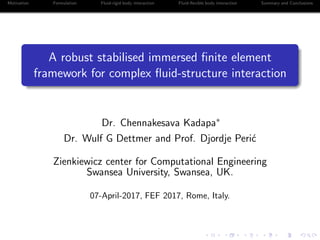This document summarizes a presentation on a robust stabilized immersed finite element framework for complex fluid-structure interaction. It discusses the motivation and requirements for modeling FSI problems with large deformations and topological changes. The formulation uses a cut-cell approach with subtriangulation and adaptive integration. Fluid equations are stabilized using SUPG, PSPG, and ghost penalties. Fluid-rigid body interaction is modeled using a staggered scheme with second-order accuracy. Fluid-flexible body interaction can be modeled with either second-order or first-order accuracy depending on the time integration and coupling scheme used. Several numerical examples are presented to validate the framework.












![Motivation Formulation Fluid-rigid body interaction Fluid-flexible body interaction Summary and Conclusions
Variational formulation for fluid problem (contd..)
Stabilisation for the fluid
Bf
Stab({wf
, q}, {vf
, p}) =
nel
e=1 Ωfe
1
ρf
[τSUPG ρf
vf
· ∇wf
+ τPSPG ∇q] · rM dΩf
+
nel
e=1 Ωfe
τLSIC ρf
(∇ · wf
) (∇ · vf
) dΩf
(4)
where, rM is the residual of the momentum equation,
rM = ρf ∂vf
∂t
+ ρf
(vf
· ∇vf
) − µf
∆vf
+ ∇p − gf
(5)
Nitsche’s method
Bf
Nitsche({wf
, q}, {vf
, p}) = γN1
ΓD
wf
· (vf
− vs
) dΓ −
ΓD
wf
· (σ({vf
, p}) · nf
) dΓ
− γN2
ΓD
(σ({wf
, q}) · nf
) · (vf
− vs
) dΓ (6)
We use γN1
= 0 and γN2
= −1.](https://image.slidesharecdn.com/fef2017-170706214513/85/A-robust-stabilised-immersed-finite-element-framework-for-complex-fluid-structure-interaction-13-320.jpg)
![Motivation Formulation Fluid-rigid body interaction Fluid-flexible body interaction Summary and Conclusions
Variational formulation for fluid problem (contd..)
Ghost penalty
Bf
GP({wf
, q)}, {(v, p)}) = γu
GP µ G1(wf
, vf
) + γp
GP
1
µ
g3(q, p)
where,
G1(w, v) :=
d
i=1 F ∈F
h2a−1
F
[Da
wi][Da
vi] ds
g3(w, v) :=
F ∈F
h2a+1
F
[Da
w][Da
v] ds
[Djz] normal derivative of z, of order j, on face F
and a is degree of b-splines. Figure: Ghost-penalty operators
are applied on blue coloured
edges.](https://image.slidesharecdn.com/fef2017-170706214513/85/A-robust-stabilised-immersed-finite-element-framework-for-complex-fluid-structure-interaction-14-320.jpg)

![Motivation Formulation Fluid-rigid body interaction Fluid-flexible body interaction Summary and Conclusions
Rotational galloping of a rectangular body - Re=250
Figure: Hierarchical mesh.
DOF max(θ) fo
Robertson et al. [3] - 0.2620 0.762 fn
Dettmer and Peri´c [4] - 0.2670 0.780 fn
Present - Level-3, Q1 61560 0.2233 0.832 fn
Present - Level-4, Q1 109713 0.2262 0.800 fn
Present - Level-3, Q2 61491 0.2833 0.800 fn
Present - Level-4, Q2 109395 0.2688 0.768 fn
Table: ρs
∞ = ρf
∞ = 0.8, β = 0.9, ∆t = 0.05.
-3.00
0.00
3.00
-5.00
5.00
vortz
-8.00
-4.00
0.00
-11.88
3.81
pres](https://image.slidesharecdn.com/fef2017-170706214513/85/A-robust-stabilised-immersed-finite-element-framework-for-complex-fluid-structure-interaction-16-320.jpg)






![Motivation Formulation Fluid-rigid body interaction Fluid-flexible body interaction Summary and Conclusions
Turek benchmark - FSI2
0 2 4 6 8 10 12 14
Time
−0.10
−0.05
0.00
0.05
0.10
Y-displacement
∆t =0.002
∆t =0.001
DOF dy fo
Turek and Hron - Level-3, ∆t = 0.002 [2] 76672 1.20 ± 79.2 2.0
Turek and Hron - Level-4, ∆t = 0.002 [2] 304128 1.25 ± 80.7 2.0
Present - Level-3, Q1, ∆t = 0.005 ≈ 70000 1.39 ± 79.6 2.0
Present - Level-3, Q1, ∆t = 0.002 ≈ 70000 1.41 ± 80.9 2.0
Present - Level-3, Q1, ∆t = 0.001 ≈ 70000 1.25 ± 79.9 2.0
Table: Y-displacement of A. Type A scheme.](https://image.slidesharecdn.com/fef2017-170706214513/85/A-robust-stabilised-immersed-finite-element-framework-for-complex-fluid-structure-interaction-23-320.jpg)

![Motivation Formulation Fluid-rigid body interaction Fluid-flexible body interaction Summary and Conclusions
Leaf in cross flow
0 5 10 15 20 25 30 35 40
Time
−0.8
−0.4
0.0
0.4
0.8
1.2
X-displacement
Ref
∆t =0.005
∆t =0.002
∆t =0.001
Figure: X-displacement of the midpoint of the leaf’s tip. Ref - [1], ∆t = 0.02.](https://image.slidesharecdn.com/fef2017-170706214513/85/A-robust-stabilised-immersed-finite-element-framework-for-complex-fluid-structure-interaction-25-320.jpg)


![Motivation Formulation Fluid-rigid body interaction Fluid-flexible body interaction Summary and Conclusions
Plate in cross flow
Domain: [0, 2] × [0.0, 0.6] × [−0.6, 0.6]
ρf
= 1.0, µf
= 0.01, vin = 10000
324 (y)(0.6 − y)(z + 0.6)(0.6 − z)
ρs
= 1.0, Es
= 200, νs
= 0.3
Type B, β = 0.02.
Figure: Fluid mesh: Q1, DOF ≈ 130,000. Solid mesh: Q1, 4 × 20 × 40.](https://image.slidesharecdn.com/fef2017-170706214513/85/A-robust-stabilised-immersed-finite-element-framework-for-complex-fluid-structure-interaction-28-320.jpg)







